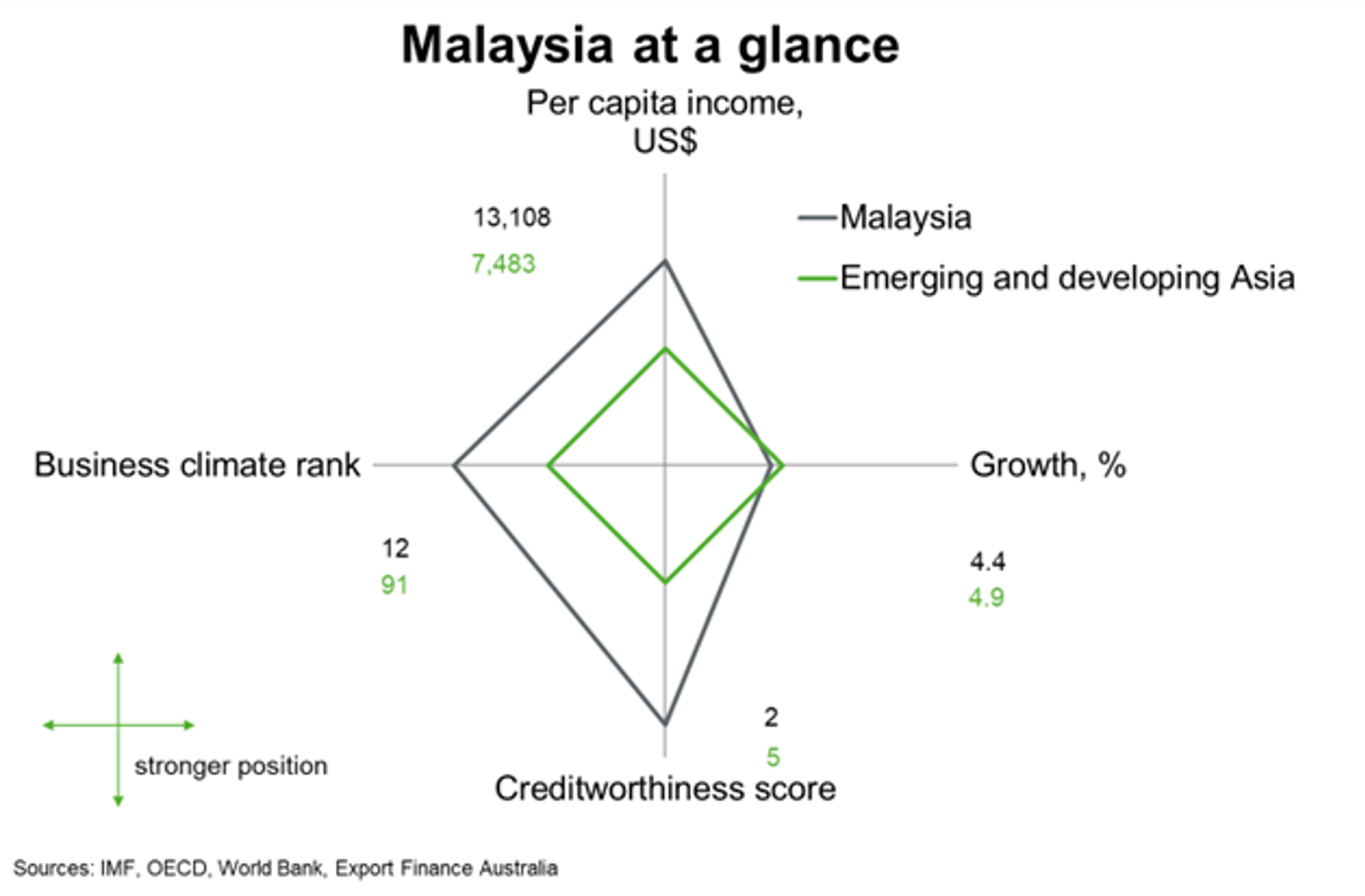
Malaysia
Malaysia
Last updated: January 2023
Malaysia has a strong economic development record. Since independence in 1957, Malaysia has expanded manufacturing, services and tourism industries to complement the country’s competitive resource sector. It is an upper middle-income, export-oriented economy. Relative to emerging and developing Asia, Malaysia has stronger creditworthiness, higher per capita incomes and more conducive business environment, while GDP growth lags its peers.

The above chart is a cobweb diagram showing how a country measures up on four important dimensions of economic performance—per capita income, annual GDP growth, business climate rank and creditworthiness. Per capita income is in current US dollars. Annual GDP growth is the five-year average forecast between 2023 and 2027. Business climate is measured by the World Bank’s 2019 Ease of Doing Business ranking of 190 countries. Creditworthiness attempts to measure a country's ability to honour its external debt obligations and is measured by its OECD country credit risk rating. The chart shows not only how a country performs on the four dimensions, but how it measures up against other countries in the region.
Economic outlook
The Malaysian economy grew by 5.4% in 2022, up from 3.1% in 2021, driven by a strong rebound in private consumption amid easing COVID restrictions and robust minerals and electronics exports.
The IMF expects real GDP growth of 4.4% in 2023 and 4.9% in 2024. In the near-term, growth will hinge on government measures to sustain private sector activity as limited fiscal space caps public investment plans. In particular, fuel price subsidies should continue to ease cost-pressures on household budgets and support private consumption. The key exports sector will face push and pull-factors in 2023. As a notable commodity exporter, Malaysian agriculture (especially palm oil) and minerals and resources exports should benefit from still-elevated commodity prices and global demand. China’s border reopening will boost services exports, particularly tourism and education. On the downside, the global economic slowdown, higher world inflation and tightening global financing conditions are expected to crimp external demand for Malaysia’s manufactured and consumer-oriented exports.
External risks to the outlook reflect the potential for a sharper global slowdown and financial turmoil that dents Malaysia’s exports and the broader economy. On the domestic front, the risk of growing tensions in the new unity government could undermine political stability and implementation of important reforms.
In the longer term, favourable demographics and an expanding middle class bode well for raising consumption growth. The government’s long-term development plan called Shared Prosperity Vision 2030, if successfully implemented, will raise labour skills, reduce wealth and income disparities and combat corruption, helping to enhance the business environment.

Malaysia is classified as an upper-middle income economy by the World Bank, with GDP per capita estimated at about US$13,000 in 2022. In the wake of the COVID-19 pandemic, the recovery in economic and social activities is strengthening Malaysia’s job market, reducing the unemployment rate (to 3.6% in November 2022) and supporting rising incomes. The World Bank expects Malaysia to reach high-income status between 2024 and 2028.

Country Risk
Country risk in Malaysia is low. Malaysia has investment grade credit ratings from major private credit rating agencies. Malaysia has an OECD Country Grade of 2, which is higher than many of its peers in Asia. The likelihood of Malaysia’s inability to service its debt obligations is low.


Malaysia’s high scores on governance indicators, particularly government effectiveness and regulatory quality, point to strong governance and institutional frameworks on a stand-alone basis and relative to other emerging and developing Asian countries. Indicators of political stability and absence of violence and voice and accountability are broadly in line with other emerging and developing Asian countries.

The risk of expropriation in Malaysia is low. Government policies indicate that all investors, both foreign and domestic, are entitled to fair compensation in the event that their private property is required for public purposes. The judicial system is generally regarded as free from political interference.

Political risk in Malaysia is low. But political uncertainty that has characterised Malaysian politics since 2018—including four Prime Ministers in nearly as many years—could persist after the November 2022 election produced a coalition of multiple parties. This could present some challenges for implementing some necessary yet politically difficult reforms.

Bilateral Relations
Malaysia was Australia’s ninth largest trading partner in 2021, accounting for around $23.3 billion or 2.5% of Australia’s bilateral trading relationship. Major Australian goods exports to Malaysia in 2021 included coal, copper and education-related travel. Major Australian goods imports included crude and refined petroleum, computers, telecommunications equipment and electronics parts.
More than 3,800 Australian businesses (mostly small and medium enterprises) trade with Malaysia, 300 of which have a physical presence in the country. Malaysia’s growing economy presents opportunities for Australian exporters of food and agribusiness (including halal food), education, health care, digital economy (e-commerce and fintech), infrastructure and resources and energy.
More broadly, the Australia–Malaysia economic relationship is underpinned by a common interest in a free and open trading system, and two free trade agreements (FTAs)—the Malaysia–Australia FTA (MAFTA) and the ASEAN–Australia–New Zealand FTA (AANZFTA). The Comprehensive and Progressive Agreement for Trans-Pacific Partnership (CPTPP) and the Regional Comprehensive Economic Partnership (RCEP) add further upside to the bilateral trade relationship.

Malaysian student enrolments in Australia have fallen steadily in the past few years, after peaking at almost 34,000 in 2018. This partly reflects a growing preference among Malaysian students to study locally, as the quality of domestic institutions improves. Malaysia was Australia’s 11th largest source of international students as of October 2022, down from sixth in 2018. Tourism’s recovery from the pandemic has been sluggish as Malaysia only opened borders for international travel in April 2022. Another year of open international should support further recovery in Malaysian demand for Australian tourism, and broader services exports, in 2023.


In terms of foreign investment stocks, Malaysia is a modest investor in Australia, owning a portfolio of $20 billion in 2021 (0.5% of the total foreign investment stock). Malaysian investment is focused on Australian property, tourism infrastructure, energy and resources and food and agribusiness. Malaysia constituted a small share of Australia’s investment abroad at $11 billion in 2021 or 0.4% of the total stock of outward investment. The Australia-Malaysia Tech Exchange (AMTX) launched in May 2021 will help Australian exporters expand their e-commerce presence in Malaysia and further promote two-way investment.


